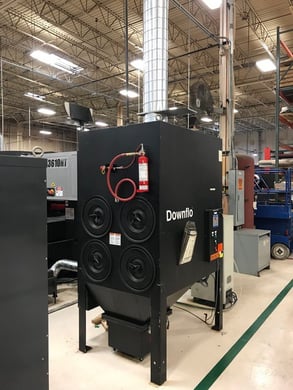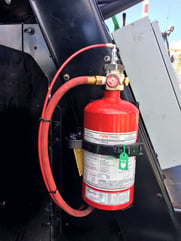Selecting and implementing the right fire suppression system can be the difference between a minor fire and a catastrophe. If you think about fire suppression systems and picture old sprinkler systems or run-of-the-mill fire extinguishers, it might surprise you to know that there are modern systems that don’t use water or foam.
In this article, we’re discussing the most reliable fire suppression systems, including their unique advantages and disadvantages, so you can identify and implement the most effective system for your situation.
What Are the Most Common Fire Suppression Systems?
The most common fire suppression systems fall into one of three categories, based on what they use to stop the fire: water, chemical agents, or clean agents.
- Water: Many businesses rely on a fire sprinkler system to protect themselves and their assets. Some sprinkler systems automatically detect smoke, heat, or fire, while others are manually triggered. Water-based systems are effective, but water poses a risk to equipment and assets, especially when electricity is present.
- Chemical Agents: Chemical agents are another option for fire suppression. Potassium carbonate, for example, can be found in conventional fire extinguishers. Similar to water, chemical agents are not suitable for all applications due to the potential for damage or other risks. The type of chemical agent used depends on the different classes of fire, as well as the specific assets that need protection.
- Clean Agents: In order to protect especially sensitive applications—like manufacturing equipment and machines, electrical panels, or data centers—where water or chemical agents could pose a risk, an clean agent fire suppression system provides an ideal solution.
What Is a Clean Agent Fire Suppression System?

A clean agent, as defined by the National Fire Protection Association (NFPA), is an electrically non-conducting, volatile, or gaseous fire extinguishant that does not leave a residue upon evaporation. For Class A, B, and C fires, these systems deploy a clean agent when a fire is in its inception stage, protecting assets before you even know there’s a fire, in many cases.
Clean agent fire suppression systems make use of a specific chemical clean agent such as FK-5-1-12 or FM-200TM.
For applications where water or mainstream chemical agents might cause damage or risk, clean agent fire suppression systems are ideal. There are multiple types of clean agents and clean agent systems, making clean agent fire suppression system comparison a crucial consideration to identify the most reliable solution for your use-case.
How Do Clean Agent Fire Suppression Systems Work?
Not all clean agents or clean agent systems are the same. So far, we’ve covered the different types of agents they use, but there are also some differences in how they work. For example, clean agent fire suppression systems can be engineered or pre-engineered, and there are direct and indirect release systems. Let’s briefly explore the differences.
Engineered vs. Pre-Engineered Systems
Clean agent fire suppression systems can be either engineered or pre-engineered. Whether you need an engineered or pre-engineered system largely depends on what’s being protected, and how.
- Engineered: An engineered system floods an entire room/area with its clean agent. Since they use a cleaning agent and not water, this prevents the damage a sprinkler system could cause to equipment.
- Pre-Engineered: A pre-engineered system is the more appropriate option for smaller, enclosed spaces or special hazards like engine compartments or electrical panels. They don’t flood the entire area; instead, they target (and suppress) a fire at its inception point.
Direct vs. Indirect Release Systems
Another factor that differentiates automatic fire agent suppression system types is whether they are direct or indirect release systems. These systems make use of fire detection tubing that releases the agent in case of a fire’s inception.
- Direct: In a direct release system, the detection tubing bursts in the specific location of the fire, applying the agent directly.
- Indirect: An indirect release system uses diffuser nozzles along the detection tubing, and when the agent is released it floods the affected area.

We work with non-electric systems, so that electricity is not required for operation—we see this as an important component of fire suppression system reliability.
At Firetrace, we provide a range of fire suppression systems designed to reliably detect fires, activate, and suppress fires before they endanger your employees and facilities. Specific benefits of these systems include:
- Fast installation
- Rapid fire detection
- Automatically-triggered fire suppression
- No risk to equipment or occupied spaces
- No false alarms
We have the trust of companies across a number of industries that benefit from clean agent systems, including manufacturing and machining, transportation and logistics, data centers, and more. Reach out directly to learn more about how our fire suppression systems can bring you a little more peace of mind.

